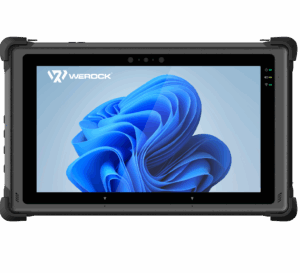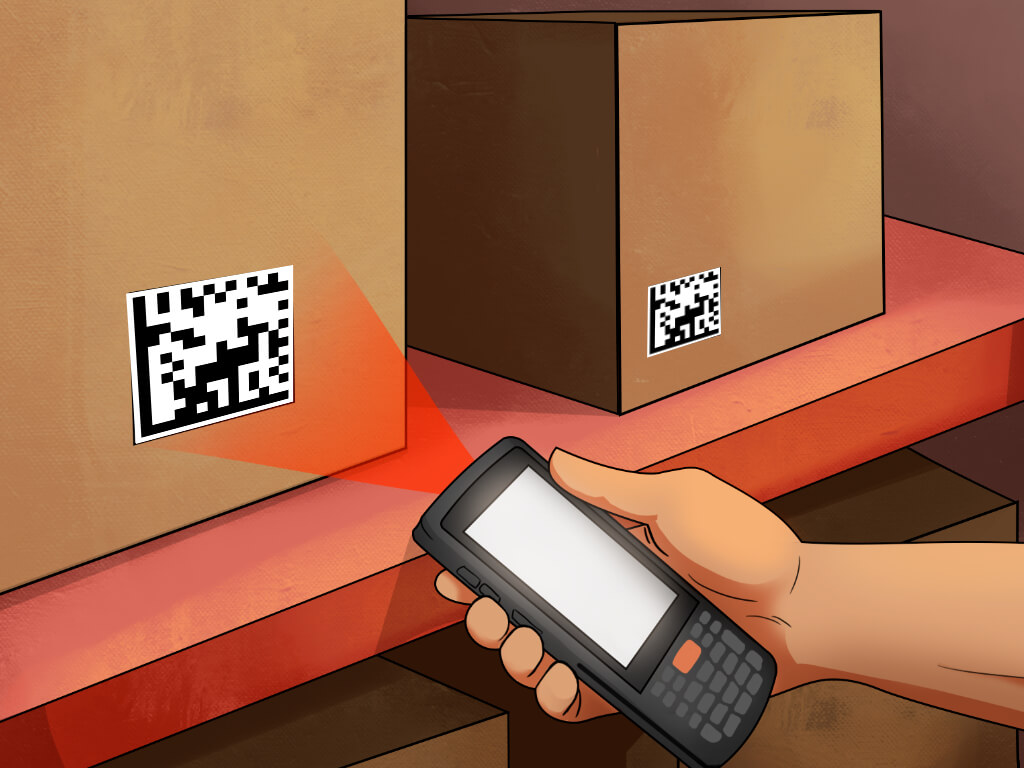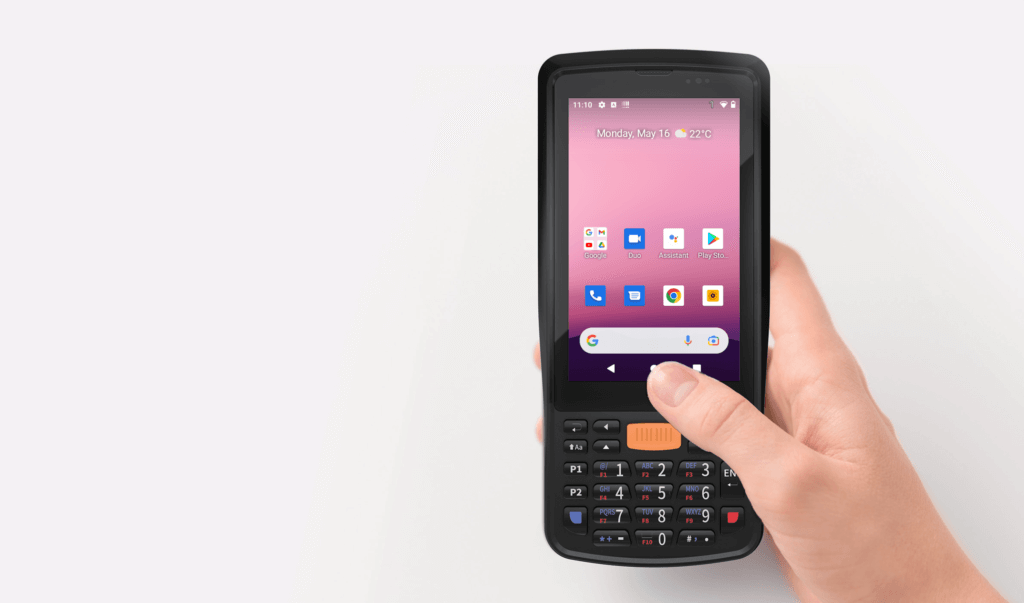Speed is the decisive factor in logistics today. It is becoming more and more commonplace for goods to be sent on their way immediately after the customer orders them. Fast delivery motivates both end consumers and business customers to buy. But the company or factory itself also benefits from a fast and smooth logistics process: Valuable time does not have to be wasted because of paper-based, inefficient data management. Long walking distances, redundant data acquisition and errors in data transmission can also be avoided. In addition to speed, precision of data acquisition, communication between workstations and transparency of delivery statuses are also crucial metrics by which the efficiency of logistics processes in operations is measured.
The technical path to such a highly efficient and qualitative logistics process is mobile data collection (MDC). With the help of MDC, data can be recorded, checked and transmitted at any location via barcodes, keyboard input or transponders. In this article, you will learn how and why the use of MDC and the corresponding devices plays a key role in increasing the efficiency of logistics processes.
Table of Contents
The whole logistics process becomes faster
First and foremost, we can observe that the entire process becomes simpler and faster with MDC, which can be attributed to a large extent to the realization of paperlessness. In the past, logistics processes were usually very paper-heavy: goods slips, picking lists, and countless manual notes were long considered indispensable (and unfortunately still are in some companies). However, it has already been clearly proven that stacks of paper lead to high employee effort and unnecessary work processes. In contrast, the use of a compact mobile device eliminates many of the problems of the paper era. The devices applied for the purpose of mobile data transfer are called mobile terminals, mobile computers, MDC devices or handheld. As a rule, mobile terminals work via WLAN or mobile Internet, so that they can be used independently of an external docking station or a stationary PC and can be used completely wirelessly. This means that the mobile computers can be used anytime and anywhere with a high degree of flexibility. With a simple tap, employees can record data directly on site, which is then automatically entered into the system. The captured electronic data is therefore immediately available and can be used immediately or even later.
So far, we have described the process in purely theoretical terms. Now we would like to outline an example scenario, each representing the daily work process of a warehouse employee with and without mobile data collection devices. This will help to illustrate the advantages of MDC devices in the optimization of work processes even more clearly.

Scenario without MDC devices
With or without mobile devices, the warehouse worker has a stack of orders to process each day. If he doesn’t have mobile tools for data transfer, he must first go to the office to get a stack of paper from his colleagues there with the order details, e.g. information on the individual order items. He then starts working through this stack of paper, taking one slip at a time. He must now remove the materials indicated on the slips of paper from storage in a preliminary storage bin and then place them back into storage in a destination storage bin. Once he has done all this, he marks the order as completed with a check mark. At the end of the day, the employee must return to the office so that the office worker receives the stack of papers again. He now has to go through the marked slips again and manually enter the checked transfer order items into his system.
Scenario with MDC devices
Although the employee also has a list of orders, he can view his stack directly on the display using a mobile data capture computer. All the current information he needs to process is also collected and displayed on the compact device; he only has to retrieve it from the WMS system, which he can do anytime, anywhere. He no longer needs to carry a lot of pieces of paper with him. Thus, they cannot get lost anywhere. Both the information about the order and the collected data are handled much more securely compared to the scenario without MDC. To confirm the removal in the pre-storage bin as well as the storage in the post-storage bin, he also only needs to scan the pallet or the bin once. At the end of the day, he also no longer needs to go to the office: The transfer order items are automatically confirmed into the WMS system by the mobile application. This saves the cumbersome and slow manual data transfer.
From these two scenarios, it can be seen that the work of a warehouse employee is made much easier with an MDC computer and the process is streamlined. The employees in both the warehouse and the office are relieved by their dependence on each other being significantly reduced and manual data work being drastically reduced or even eliminated. This gives you more time to devote to other tasks. Furthermore, productive and efficient warehouse management is the basis of satisfactory logistics operations, which can then also proceed more smoothly with the help of MDC.
The quality of data acquisition is increased
However, MDC not only optimizes the speed of logistical work processes; it also significantly improves the quality of work. In addition to the accuracy of the data collection itself, this also applies to the traceability and transparency of the data at each logistics station. This leads to better cooperation between colleagues throughout the company, which ultimately also ensures improved customer satisfaction.
Precision
The accuracy of data recording and transmission increases many times over. The elimination of double data entry in digital and paper form eliminates transmission errors between paper and PC. The MDC device also automatically checks the correctness and plausibility of the scanned barcodes at the time of data entry. This check ensures that the employee removes the correct materials from storage and places them back in the correct location. In addition, the possible sources of error – such as typing errors, transposed numbers, transposed letters, etc. – are avoided. – are avoided when entering data manually. As a result, all process steps run much more reliably with MDC than without it, and the overall data quality is significantly increased in the end.
Traceability
Traceability is particularly important for logistics processes. If the employee can enter the current information on the status of goods, delivery progress and movements directly into the central database on site, the data is available to all employees in the plant in real time. This means that the goods can always be located and their available quantity can be retrieved and determined at any time.
The traceability of goods also plays an important role for the end consumer: if the customer sees the delivery progress of his order, this immediately increases his trust in the supplier. We all know this: it’s usually not the long duration of the delivery that annoys us, but precisely the uncertainty as to when our order will finally arrive. In the event of delivery delays or the loss of goods, this is very advantageous if packages can be clearly identified with their own barcode and the delivery route is designed to be traceable step by step for everyone involved.
Use and application of the MDC devices
In MDC, handheld computers or tablet PCs are often used that are equipped with an integrated barcode scanner to read barcodes or RFID tags. Here, the functionality and performance of the barcode scanner is one of the decisive factors for the effect of the MDC application. These devices usually have very good WLAN, Bluetooth and LTE connectivity, so that the connection and transmission of data is possible regardless of time and space. Because these mobile terminals are often used in practice for integration in vehicles, such as forklifts (here often so-called forklift terminals) or cranes, and generally a lot in the field, they are usually particularly rugged. This means that they should be able to withstand difficult working conditions in the field well, such as vibrations, falls, impacts, scratches, moisture, dust, etc.
Mobile terminals are already widely used in various business processes in logistics, transportation and warehouse management. In goods picking and inventory, they are now firmly established in many companies. They also play a major role in preparing goods for shipment: packages marked with barcodes can be clearly identified and assigned by transport companies.
However, the potential applications of MDC are not limited to the logistics and warehousing sectors. Due to the high time savings, the simple operation and the great power to optimize the work organization, the mobile terminals are used in virtually all industries. In the general goods management system, in retail, and even in healthcare, MDC devices are used to speed up the flow of data between different workstations and to eliminate errors through automation.
Conclusion
Mobile data capture devices contribute to the modernization, digitalization and optimization of logistics processes. Overall, countless paper lists, notepads and printed forms are replaced by mobile devices and a uniform data management system, walking distances are enormously reduced or eliminated altogether, communication between warehouse, sales, purchasing, finance and other departments is simplified, logistical movements are recorded more easily, faster and at the same time with higher quality.
Mobile data capture devices bring both young and established companies one step closer to a digitized way of working. We can safely say that paperwork is a thing of the past; those who welcome the new mobile technology with open arms will find new opportunities in logistical business processes. Through MDC, many companies have already optimized their logistics processes. This is the only way to withstand the ever-increasing competitive pressure.













